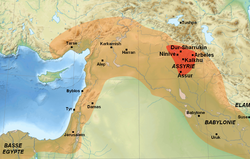
Back Assirië Afrikaans Assyrien ALS አሦር Amharic آشور Arabic ܐܬܘܪ ARC الاشوريين ARZ Asiria AST Assuriya Azerbaijani آشوریلر AZB Ассирия Bashkir
Assyria | |||||||||||
|---|---|---|---|---|---|---|---|---|---|---|---|
| c. 2025 BC[a]–609 BC[b] | |||||||||||
|
Symbol of Ashur, the ancient Assyrian national deity | |||||||||||
 Map showing the ancient Assyrian heartland (red) and the extent of the Neo-Assyrian Empire in the 7th century BC (orange) | |||||||||||
| Capital |
| ||||||||||
| Official languages | |||||||||||
| Religion | Ancient Mesopotamian religion | ||||||||||
| Government | Monarchy | ||||||||||
| Notable kings | |||||||||||
• c. 2025 BC | Puzur-Ashur I (first) | ||||||||||
• c. 1974–1935 BC | Erishum I | ||||||||||
• c. 1808–1776 BC | Shamshi-Adad I | ||||||||||
• c. 1700–1691 BC | Bel-bani | ||||||||||
• c. 1363–1328 BC | Ashur-uballit I | ||||||||||
• c. 1243–1207 BC | Tukulti-Ninurta I | ||||||||||
• 1114–1076 BC | Tiglath-Pileser I | ||||||||||
• 883–859 BC | Ashurnasirpal II | ||||||||||
• 745–727 BC | Tiglath-Pileser III | ||||||||||
• 705–681 BC | Sennacherib | ||||||||||
• 681–669 BC | Esarhaddon | ||||||||||
• 669–631 BC | Ashurbanipal | ||||||||||
• 612–609 BC | Ashur-uballit II (last) | ||||||||||
| Historical era | Bronze Age to Iron Age | ||||||||||
• Foundation of Assur | c. 2600 BC | ||||||||||
• Assur becomes an independent city-state | c. 2025 BC[a] | ||||||||||
| c. 2025–1364 BC | |||||||||||
| c. 1363–912 BC | |||||||||||
| 911–609 BC | |||||||||||
• Conquest by the Neo-Babylonian and Median empires | 609 BC[b] | ||||||||||
| |||||||||||
| Periodization of ancient Assyria | ||||||||||
|---|---|---|---|---|---|---|---|---|---|---|
|
||||||||||
|
See also: History of the Assyrians |
Assyria (Neo-Assyrian cuneiform: ![]()
![]()
![]()
![]() , māt Aššur) was a major ancient Mesopotamian civilization which existed as a city-state from the 21st century BC to the 14th century BC, then to a territorial state, and eventually an empire from the 14th century BC to the 7th century BC.[4]
, māt Aššur) was a major ancient Mesopotamian civilization which existed as a city-state from the 21st century BC to the 14th century BC, then to a territorial state, and eventually an empire from the 14th century BC to the 7th century BC.[4]
Spanning from the early Bronze Age to the late Iron Age, modern historians typically divide ancient Assyrian history into the Early Assyrian (c. 2600–2025 BC), Old Assyrian (c. 2025–1364 BC), Middle Assyrian (c. 1363–912 BC), Neo-Assyrian (911–609 BC) and post-imperial (609 BC–c. AD 240) periods, based on political events and gradual changes in language.[5][6] Assur, the first Assyrian capital, was founded c. 2600 BC but there is no evidence that the city was independent until the collapse of the Third Dynasty of Ur in the 21st century BC,[3] when a line of independent kings beginning with Puzur-Ashur I began ruling the city. Centered in the Assyrian heartland in northern Mesopotamia, Assyrian power fluctuated over time. The city underwent several periods of foreign rule or domination before Assyria rose under Ashur-uballit I in the early 14th century BC as the Middle Assyrian Empire. In the Middle and Neo-Assyrian periods Assyria was one of the two major Mesopotamian kingdoms, alongside Babylonia in the south, and at times became the dominant power in the ancient Near East. Assyria was at its strongest in the Neo-Assyrian period, when the Assyrian army was the strongest military power in the world[7] and the Assyrians ruled the largest empire then yet assembled in world history,[7][8][9] spanning from parts of modern-day Iran in the east to Egypt in the west.
The Neo-Assyrian Empire fell in the late 7th century BC, conquered by a coalition of the Babylonians, who had lived under Assyrian rule for about a century, and the Medes. Though the core urban territory of Assyria was extensively devastated in the Medo-Babylonian conquest of the Assyrian Empire and the succeeding Neo-Babylonian Empire invested few resources in rebuilding it, ancient Assyrian culture and traditions continued to survive for centuries throughout the post-imperial period. Assyria experienced a recovery under the Seleucid and Parthian empires, though declined again under the Sasanian Empire, which sacked numerous cities and semi independent Assyrian territories in the region, including Assur itself. The remaining Assyrian people, who have survived in northern Mesopotamia to modern times, were gradually Christianized from the 1st century AD onward. Ancient Mesopotamian religion persisted at Assur until its final sack in the 3rd century AD, and at certain other holdouts for centuries thereafter.[10]
The triumph of ancient Assyria can be attributed not only to its vigorous warrior-monarchs but also to its adeptness in efficiently assimilating and governing conquered territories using inventive and advanced administrative mechanisms. The developments in warfare and governance introduced by ancient Assyria continued to be employed by subsequent empires and states for centuries.[7] Ancient Assyria also left a legacy of great cultural significance,[11] particularly through the Neo-Assyrian Empire making a prominent impression in later Assyrian, Greco-Roman and Hebrew literary and religious tradition.[12][13][c]
- ^ Düring 2020, p. 39.
- ^ Lambert 1983, pp. 82–85.
- ^ a b Roux 1992, p. 187.
- ^ "Assyria | History, Map, & Facts". Britannica. 6 July 2023. Retrieved 13 August 2023.
- ^ Frahm 2017a, p. 5.
- ^ Hauser 2017, p. 229.
- ^ a b c Aberbach 2003, p. 4.
- ^ Düring 2020, p. 133.
- ^ Frahm 2017b, p. 161.
- ^ Parpola 2004, p. 21.
- ^ Frahm 2017b, p. 196.
- ^ Frahm 2017b, pp. 195–196.
- ^ Kalimi & Richardson 2014, p. 5.
Cite error: There are <ref group=lower-alpha> tags or {{efn}} templates on this page, but the references will not show without a {{reflist|group=lower-alpha}} template or {{notelist}} template (see the help page).
